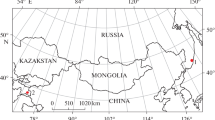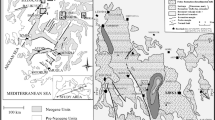Abstract
The paper addresses the composition and genesis of endogenous borates from hypabyssal skarn deposits of Japan (Honshu Island) that were formed after dolomitic, rhodochrosite, and calcareous marbles in the contact aureoles of magmatic intrusions of diverse felsicity (from granites to diorite-monzonites). Metasomatic bodies formed at the prograde stage of the mineral formation are characterized by clearly expressed zoning of primitive type. Borates occur in the calciphyres at the Neichi, Kaso, and Rito mines, and are developed in calcitic marbles at the Fuka mine. Depending on initial composition of carbonate rocks, borates are represented by suanite, kotoite, jimboite, and takedaite in the outer zones of spinel-forsterite and galaxite-jacobsite-tephroite calciphyres or calcitic marbles, respectively. It was shown that early borates are subjected to hydration that is expressed in variable deficit of boron. At the next stages of hydrothermal mineral formation, they are replaced by pertsevite, wiserite, sibirskite, and other borates.
Similar content being viewed by others
References
T. Watanabe, A. Kato, and T. Katsura, “Kotoite Mg3[BO3]2 from Neichi Mine, Iwate Prefecture, Japan,” Proc. Acad. Sci. 39(3), 164–169 (1963).
T. Watanabe, A. Kato, T. Matsumoto, and J. Ito, “Jimboite Mn3[BO3]2, a New Mineral from the Kaso Mine, Tochigi Prefecture, Japan,” Proc. Acad. Sci. 39(3), 170–175 (1963).
T. Watanabe, C. Yui, and A. Kato, “Bedded Manganese Dtposits in Japan, a Review,” in Volcanism and Ore Genesis, (Univ. Press. Tokyo, Tokyo, 1970), pp. 119–142.
T. Watanabe, “Characteristic Feature of the Ore Deposits Found in Contact Metamorphic Aureoles in Japan,” Int. Geol. Rev. 2, 946–966 (1960).
I. Kusachi, C. Hemni, and S. Kobayashi, “Takedaite, a New Mineral from Fuka, Okayama Prefecture, Japan,” Mineral. Mag. 59, 549–553 (1995).
S. M. Aleksandrov, “Endogenous Transformations of Kotoite in Calciphyres at Magnesian-Skarn Deposits of Boron,” Geochem. Int. 45(7), 666–684 (2007).
S. M. Aleksandrov, “Geochemical Features of the Endogenous Hydration of Magnesium Borates,” Geochem. Int. 46, 578–594 (2008).
S. M. Aleksandrov, “Genesis and Composition of Ore-Forming Magnesian Borates, Their Analogues, and Modifications,” Geochem. Int. 41(5), 440–458 (2003).
S. M. Aleksandrov and M. A. Troneva, “Genesis and Composition of Ludwigite-Vonsenite Borate Series in Magnesian Skarn of Central and East Asia,” Geochem. Int. 42, 870–886 (2004).
S. M. Aleksandrov, V. L. Barsukov, and V. V. Shcherbina, Geochemistry of Endogenous Boron (Nauka, Moscow, 1968) [in Russian].
S. M. Aleksandrov and M. A. Troneva, “Composition and Genesis of Endogenous Borates from the Pitkaranta Ore Field, Karelia,” Geochem. Int. 47(9), 914–929.
S. M. Aleksandrov, “Skarn-Greisen Deposits of the Lost River and Mount Ear Ore Field, Seward Peninsula, Alaska, United States,” Geochem. Int. 48(12), 1220–1236 (2010).
T. Yosimura, “Studies on the Minerals from the Manganese Deposit of the Kaso Mine, Japan,” J. Faculty Sci., Hokkaido Imper. Univ. Ser. IV. Geol. Mineral. 4(3–4), 361–451 (1939).
S. M. Aleksandrov, “Genesis and Mineralogical Composition of Manganese Skarn of Prograde and Retrograde Stages of Metasomatism in Carbonate Rocks,” Geochem. Int. 40, 649–663 (2002).
S. M. Aleksandrov, Geochemistry of Skarn and Ore Formation in Dolomites (VSP, Utrecht-Tokyo, 1998).
S. M. Aleksandrov, “Genesis and Mineralogy of Calc Skarns of the Prograde and Retrograde Metasomatic Stages,” Geochem. Int. 40, 244–259 (2002).
W. T. Epprecht, W. T. Schaller, and A. C. Vlisidis, “Uber Wiserit, Sussexit und Weiteres Mineral aus den Manganezen von Gonsen (bei Sargans), Schweiz,” Mineral. Petrol. Mitt. 39(1), 85–104 (1959).
P. J. Dunn, C. A. Francis, R. A. Ramik, J. A. Nelen, J. Innes, “Wiserite, An Occurrence at the Kombat Mine in Namibia, and New Data,” Am. Mineral. 74(11), 1374–1376 (1989).
F. Pertlik and P. J. Dunn, “Crystal Structure of Wiserit,” Am. Mineral. 74(11), 1351–1354 (1989).
A. Kato and S. Matsubara, “Manganese Borate Minerals from Japan,” J. Mineral. Soc. Japan Sp. Publ. 14(3), 86–97 (1980).
A. Omae, I. Kusachi, and Sh. Kobayashi, “Petrology of the Igneous Rocks Forming High-Temperature Skarns at Fuka, Okayama, Japan,” Jap. Mag. Miner. Petrol. Sci. 31(1), 1–14 (2002).
I. Kusachi, Ch. Henmi, and Sh. Kobayashi, “Sibirskite from Fuka, Okayama Prefecture, Japan,” Mineral. J. 19(3), 109–114 (1997).
I. Kusachi, Y. Takechi, Ch. Henmi, and Sh. Kobayashi, “Borcarite from Fuka, Okayama Prefecture, Japan,” Mineral. J. 19(3), 115–122 (1997).
M. Ohnishi, I. Kusachi, S. Kobayashi, and J. Yamakawa, “Numanoite Ca4CuB4O6(OH)6(CO3)2, a New Mineral, the Cu-Analogue of Borcarite from Fuka Mine, Okayama Prefecture, Japan,” in 19th General Meeting of IMA, Kobe, Japan, 2006 (Kobe, 2006).
M. Ohnishi, I. Kusachi, S. Kobayashi, J. Yamakawa, M. Tanabe, S. Kishi, and T. Yasuda, “Numanoite, Ca4CuB4O6(OH)6(CO3)2, a New Mineral Species, the Cu Analogue of Borcarite from Fuka Mine, Okayama Prefecture, Japan,” Can. Mineral. 45, 307–315 (2007).
I. Kusachi and Ch. Henmi, “Nifontovite and Olshanskyite from Fuka, Okayama Prefecture, Japan,” Mineral Mag. 58(2), 279–284 (1994).
I. Kusachi, Y. Takechi, Ch. Henmi, and Sh. Kobayashi, “Parasibirskite, a New Mineral from Fuka, Okayama Prefecture, Japan,” Mineral. Mag. 62(4), 521–525 (1998).
I. Kusachi, Ch. Henmi, and Sh. Kobayashi, “Frolovite from Fuka, Okayama Prefecture, Japan,” Mineral. J. 17(7), 330–337 (1995).
I. Kusachi, Y. Takechi, Sh. Kobayashi, J. Yamakawa, Y. Nakamuta, K. H. Lee, Sh. Motomizu, “Hexahydroborite from Fuka, Okayama Prefecture, Japan,” Mineral J. 2(1), 9–14 (1999).
I. Kusachi, Ch. Henmi, and K. Henmi, “An Oyelite-Bearing Vein at Fuka, the Town Bitchu, Okayama Prefecture,” J. Japan. Assoc. Min. Petr. Econ. Geol. 79(7), 267–275 (1984).
I. Kusachi, “New Data on Mineralogical Properties of Henmilite,” J. Miner. Soc. Japan 21(3), 127–130 (1992).
I. Kusachi, Ch. Henmi, and Sh. Kobayashi, “Chemical Composition of Bakerite from Fuka, Okayama Prefecture, Japan,” Mineral. J. 17(3), 111–117 (1994).
U. L. Schafer, “Synthese und Rontgenographishe Untersuchingder Borate 3CaO · B2O3, 2CaO · B2O3 und 2CaO · B2O3 · H2O,” Neues Jahrb. Mineral. Mh. 75–80 (1968).
V. V. Kondrat’eva,, X-ray Diffraction Guide for Borates, (Nedra, Leningrad, 1969) [in Russian].
Malinko, S.V., Khalturina, I.I., Ozol, A.A., and Bocharov, V.M., Boron Minerals (Nedra, Moscow, 1991).
S. M. Aleksandrov, “Assimilation of Metamorphic and Metasomatically Altered Carbonate Rocks by Granitic Magmas,” Geokhimiya, No. 11, 1398–1415 (1992).
S. M. Aleksandrov, “Skarn Formation after Dolomites in Contact with Granitic Magmas,” Geokhimiya, No. 6, 801–820 (1993).
S. M. Aleksandrov, “Metasomatic Transformations of Carbonate Rocks Observable in Quarries of Riverside, California, United States,” Geochem. Int. 49(7), 711–725 (2011).
T. Watanabe, “Suanite, a New Magnesium Borate Mineral from Hol-Kol, Suan, North Korea,” Mineral. J. 1(1), 54–62 (1953).
W. Schreyer, T. Armbruster, H-J. Bernhardt, and O. Medenbach, “Pertsevite, a New Silicatian Magnesioborate Mineral with an End-Member Composition Mg2BO3F, in Kotoite Marble from East of Verkhoyansk, Sakha-Yakutia, Russia,” Eur. J. Mineral. 15(6), 1007–1018 (2003).
S. M. Aleksandrov and M. A. Troneva, “Chromium Isomorphism in Endogenic Borates and Geochemical Characteristics of Their Genesis,” Geochem. Int. 36(7), 674–696 (1998).
Author information
Authors and Affiliations
Corresponding author
Additional information
Original Russian Text © S.M. Aleksandrov, M.A. Troneva, 2012, published in Geokhimiya, 2012, Vol. 50, No. 11, pp. 987–1001.
Rights and permissions
About this article
Cite this article
Aleksandrov, S.M., Troneva, M.A. Genesis and composition of borates in the metasomatically altered dolomitic, rhodochrosite, and calcareous marbles of Japan. Geochem. Int. 50, 885–898 (2012). https://doi.org/10.1134/S001670291211002X
Received:
Accepted:
Published:
Issue Date:
DOI: https://doi.org/10.1134/S001670291211002X




